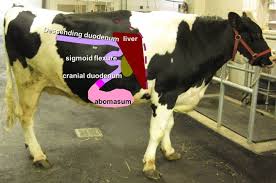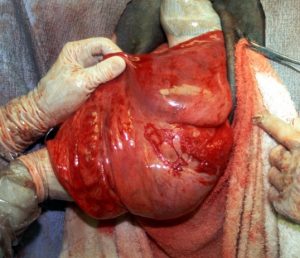FA GI Topics
Duodenal Outflow Problems
Duodenal outflow problems can occur in any age or breed and are due to obstruction or dysfunction. Duodenal dysfunction can occur due to peracute duodentitis, duodenal ulcers with or without perforation, clostridial duodenitis, or electrolyte abnormalities. Duodenal obstruction can occur due to trichobezoars (calves infested with lice or mites, or adult cattle in spring when shedding of hair occurs), foreign bodies, duodenal stricture after an ulcer, obstruction by displacement of the viscera (gall bladder or uterus), iatrogenic after omentopexy or pyloropexy, and/or extraluminal compression (liver abscess, omental abscess, or lymphosarcoma). Cases of duodenal sigmoid flexure volvulus have been described in cattle post omentopexy.

Clinical Examination
Animals with a duodenal outflow problem with present with clinical signs of dehydration, colic, weight loss, anorexia, recumbency, lethargy, and/or decreased fecal production. On physical exam, they have progressive right abdominal distension due to fluid buildup in the rumen, resembling severe bloat. On rectal examination there may or may not be palpable loops of small intestine. Ultrasound will identify distention of the duodenum and forestomach.
-

Calf with abdominal distention due to a duodenal obstruction. Picture from: Burgstaller, et al. Abomasal emptying in calves and its potential influence on gastrointestinal disease. Journal of Dairy Science, 2016.
Treatment
This disorder requires immediate surgical exploratory via a right paracostal approach (beside the rib) and removal of the obstruction via enterotomy if identified. Treatment also includes IV fluids for stabilization, antibiotics, NSAIDs, and additional analgesics. If a cause cannot be determined, a presumptive diagnosis of ileus is made and the cow is treated aggressively with IV fluids for 12-24 hours.

Resources
Duodenal obstruction caused by duodenal sigmoid flexure volvulus in dairy cattle. J Am Vet Med Assoc 2012 Sep 1;241(5):621-5
tacking the omentum in place to prevent movement of the abomasum

